1. Biography and Early Career
Jacopo della Quercia's early life and artistic development were shaped by his family's background in craftsmanship and the rich artistic environment of Siena and its surroundings. His formative years saw him absorb diverse influences that would later define his unique style, leading him to compete for prestigious commissions early in his career.
1.1. Birth and Family Background
Jacopo della Quercia was born around 1374 in Quercia Grossa (now Quercegrossa), a locality near Siena, Tuscany, from which he derived his name. His family had a strong artistic lineage; his father, Piero d'Angelo, was a respected woodcarver and goldsmith, and his brother, Priamo, was a painter. This familial environment undoubtedly provided Jacopo with his earliest exposure to art and craft. In 1386, due to prevailing political strife and disturbances in Siena, Jacopo and his father relocated to Lucca.
1.2. Early Artistic Influences and Training
Della Quercia received his initial artistic training from his father. Living in Siena, he would have been exposed to the works of prominent earlier sculptors like Nicola Pisano and Arnolfo di Cambio, particularly their pulpit in the Siena Cathedral, which significantly influenced his early development. It is also highly probable that della Quercia extensively studied the vast collection of Roman sculptures and sarcophagi housed in the Camposanto in Pisa. These ancient works, combined with later influences, positioned him as a transitional figure in European art. His work clearly demonstrates a marked shift from the prevalent Gothic style towards the burgeoning Italian Renaissance aesthetic. This evolution, similar to that observed in the work of his contemporary Ghiberti, was likely a result of his interaction with and exposure to artists like Donatello.
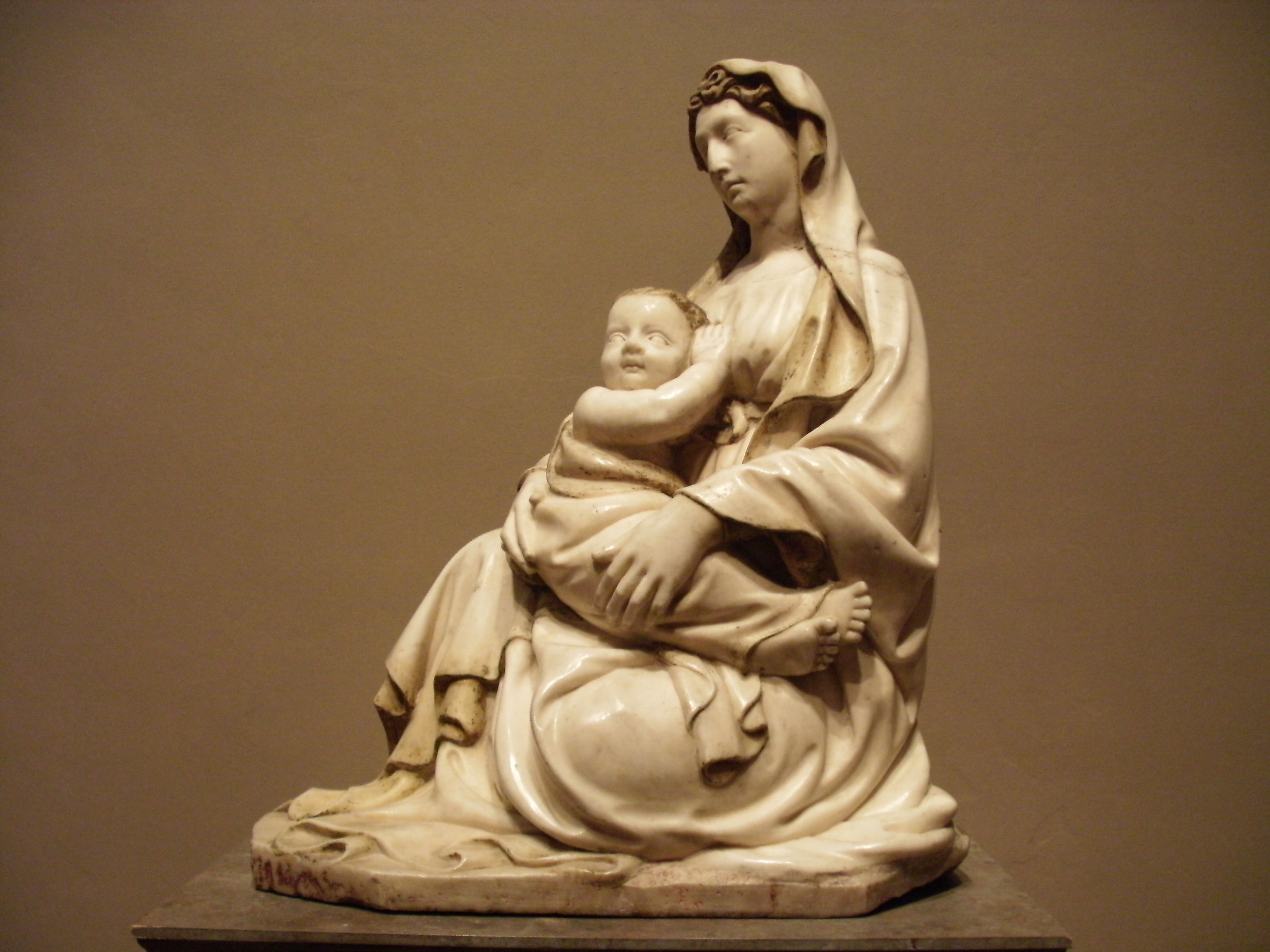
1.3. Early Commissions and the Florence Baptistery Competition
Jacopo della Quercia's potential first documented work, possibly executed at the age of sixteen around 1390, was an equestrian wooden statue created for the funeral of Azzo Ubaldini. Early works attributed to him, though sometimes contested, are found in the Lucca Cathedral, including the Man of Sorrows (located at the Altar of the Sacrament) and a relief on the tomb of St. Aniello. In 1401, della Quercia participated in a highly significant competition to design the bronze doors for Florence's Baptistery. He ultimately lost this prestigious commission to Lorenzo Ghiberti, and the whereabouts of his unsuccessful entry remain unknown. Following this, in 1403, he sculpted the marble Virgin and Child for the Ferrara Cathedral, and a statuette of St. Maurelius (circa 1403), both of which are now displayed in the Museo del Duomo.
2. Major Works
Jacopo della Quercia's career was marked by a series of monumental commissions that allowed him to refine his distinctive style, characterized by a powerful blend of Gothic grace and Renaissance classicism. His projects spanned across Tuscany and Emilia-Romagna, leaving a lasting legacy on the artistic landscape of Italy.
2.1. Tomb of Ilaria del Carretto
Returning to Lucca in 1406, Jacopo della Quercia received a significant commission from the city's ruler, Paolo Guinigi, to create the tomb for his second wife, Ilaria del Carretto, in the Lucca Cathedral. Completed around 1406, this tomb is a landmark work. The richly dressed figure of Ilaria rests delicately atop the sarcophagus, portrayed in a refined Gothic fashion, with her dog - a traditional symbol of conjugal fidelity - resting at her feet. However, a striking departure from purely Gothic conventions is visible in the use of several nude putti positioned along the flanks of the tomb. These figures clearly demonstrate the classical influence of the Roman sarcophagi that della Quercia had studied at Camposanto in Pisa. This innovative integration of classical elements within a Gothic framework marks the tomb as a harbinger of the incipient Renaissance style in sculpture.
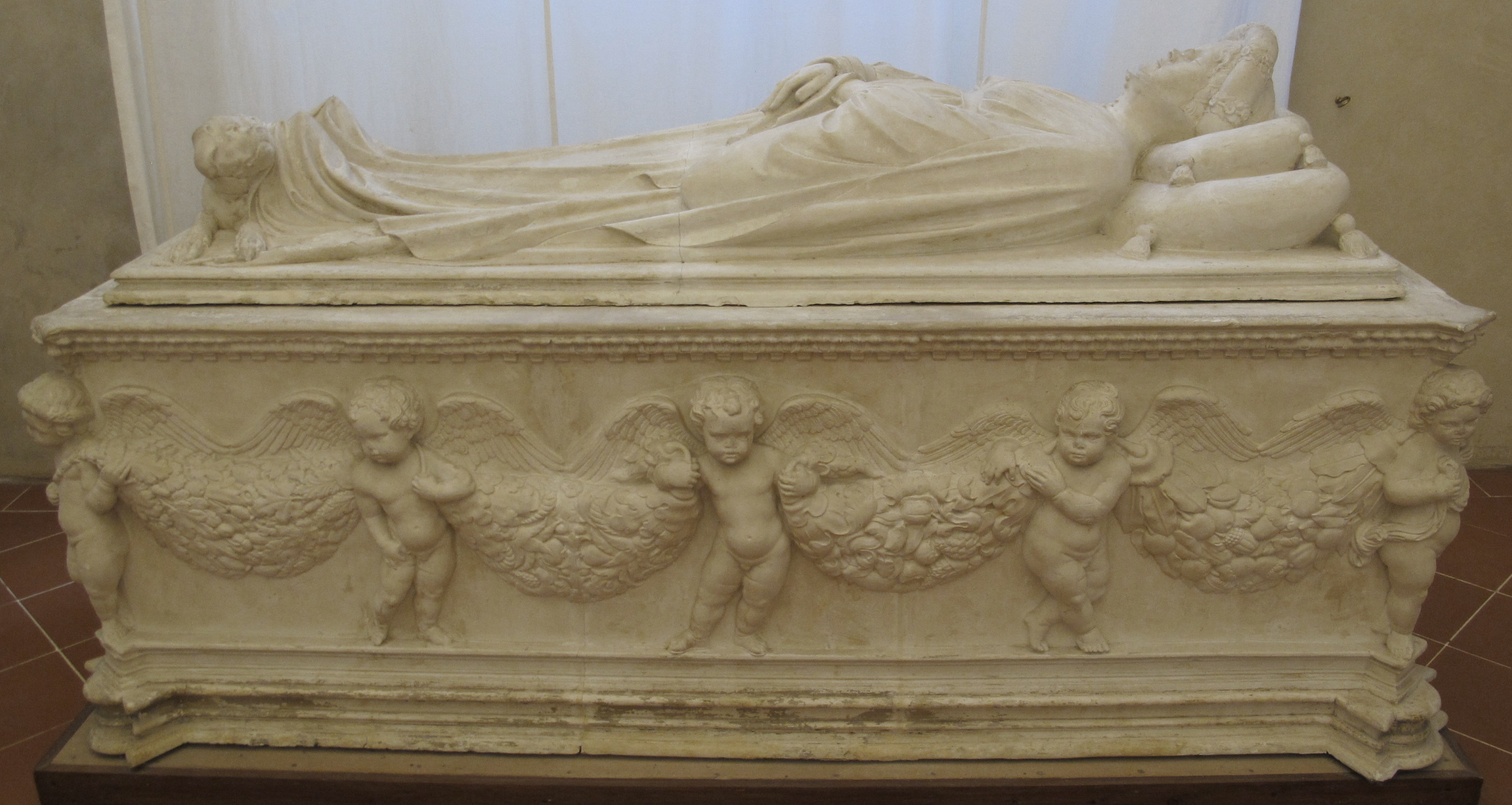
2.2. Fonte Gaia in Siena
In 1406, Jacopo della Quercia was commissioned to construct a new fountain in the Piazza del Campo in Siena. This project held considerable symbolic importance, as it was intended to replace an older fountain featuring a statue of the pagan goddess Venus. The Venus statue had been controversially blamed for an outbreak of the Black Death and was consequently destroyed and buried outside the city walls to avert its perceived "evil influence." This prestigious commission, awarded to della Quercia, underscored his growing recognition as Siena's foremost sculptor.
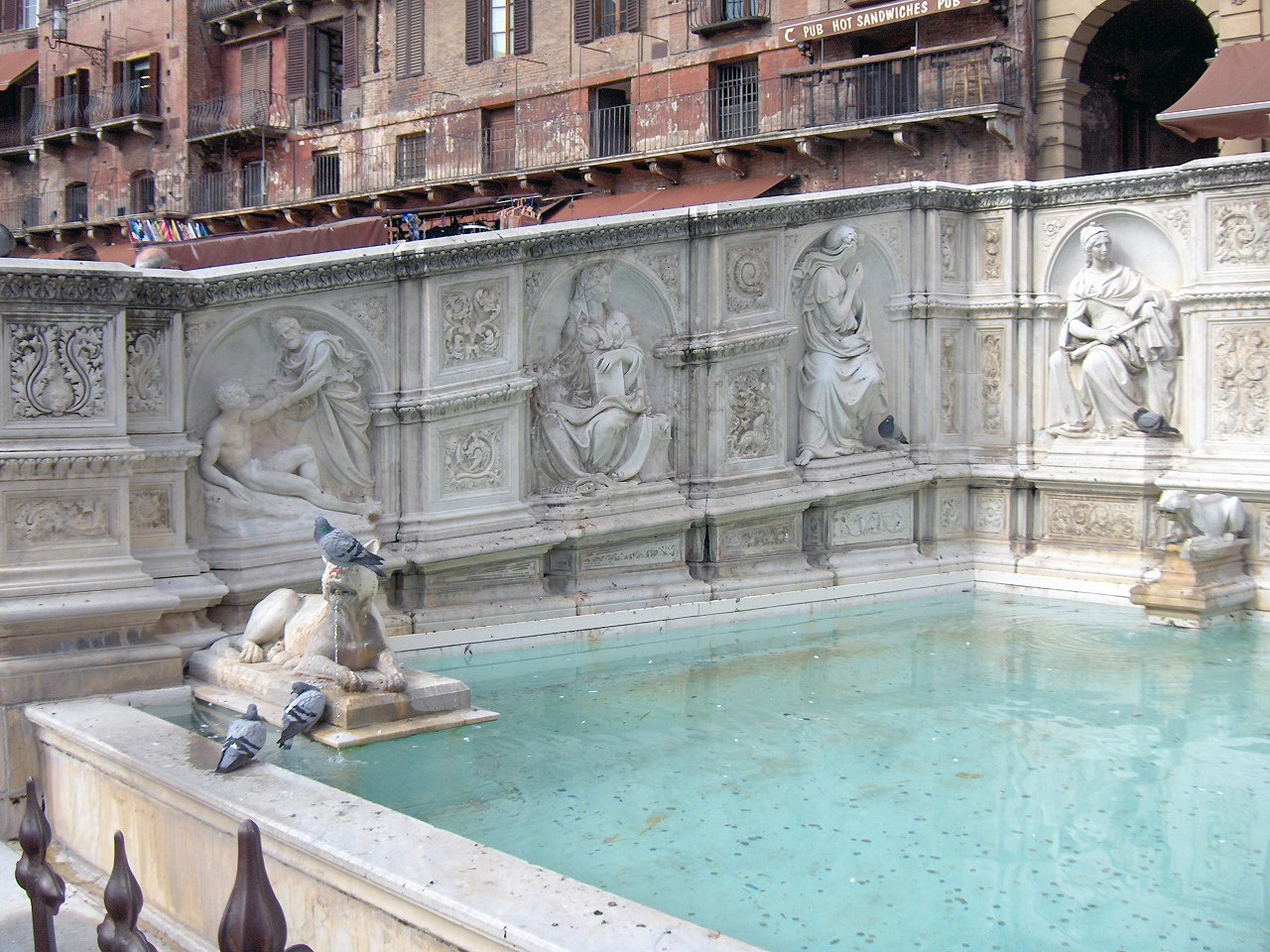
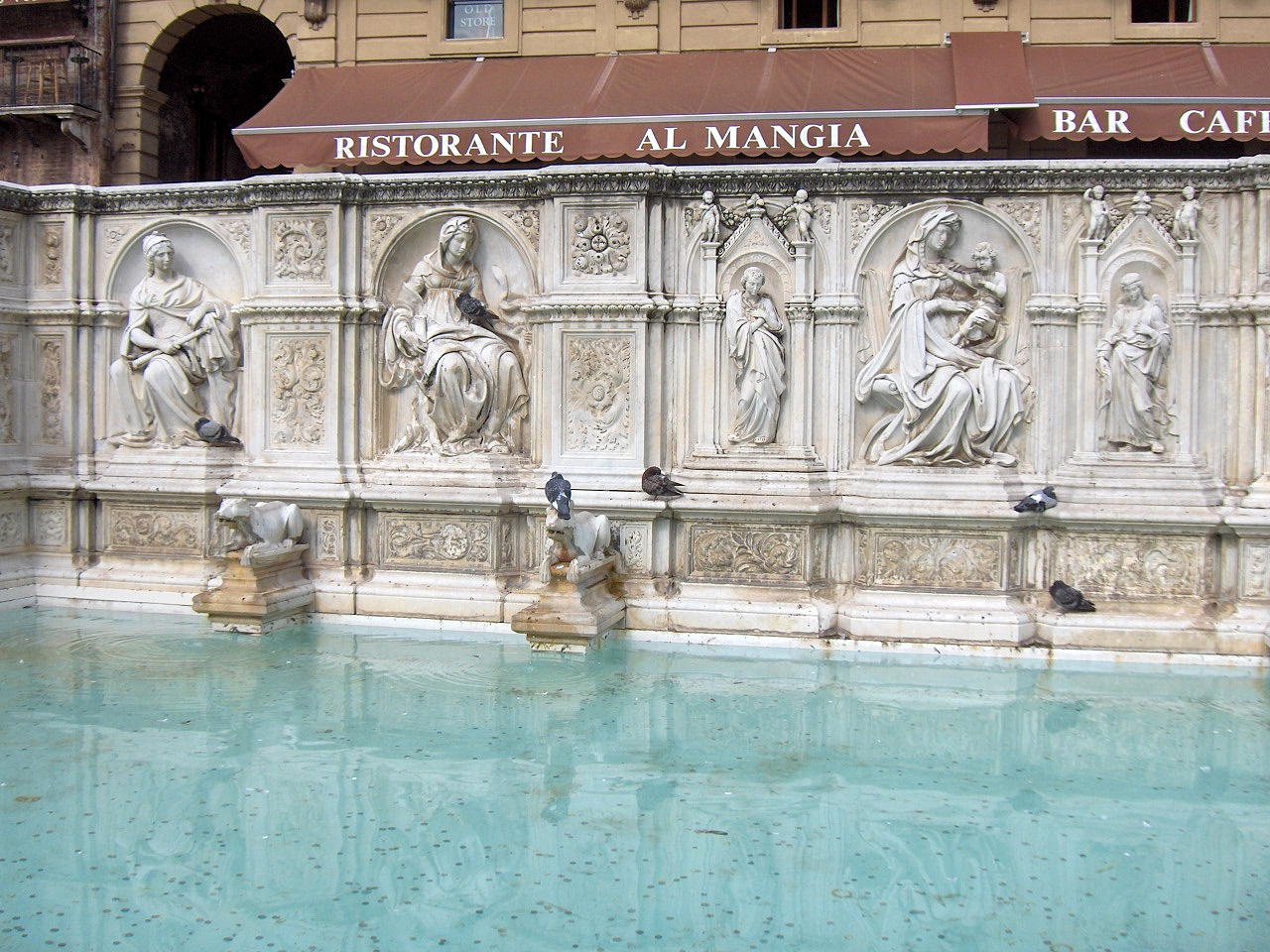
The new rectangular fountain, built of white marble, was dedicated to the Virgin Mary and adorned on its three sides with numerous statues and multiple spouts. Due to della Quercia's concurrent commitments to other commissions, the progress on the Fonte Gaia was slow; work began in 1414 and the fountain was not completed until 1419. The panels were carved in the workshop adjacent to the Siena Cathedral, which has since been converted into the Cathedral Museum. The fountain was named Fonte Gaia, meaning "Joyful Fountain," reflecting the public's excitement and the festivities that accompanied its inauguration. Today, it remains a significant tourist attraction. The original statues, which featured the Virgin and Child and eight female personifications of virtues, were eventually replaced by copies made by Tito Sarrocchi in 1858. The deteriorated original statues are now displayed in the lower levels of Santa Maria della Scala or the Palazzo Pubblico in Siena.
2.3. Other Commissions in Lucca and Siena
Jacopo della Quercia undertook several other important works throughout his active career. In 1412, he was contracted by the wealthy merchant Lorenzo Trenta to design the Trenta Chapel within the Basilica di San Frediano in Lucca. He continued work on this chapel intermittently, creating a marble altar and several statues of saints housed in niches, with some assistance from his workshop. He also designed the tomb slabs for Lorenzo Trenta and his wife, Isabetta Onesti, on the pavement in front of the altar.
In 1416, despite Lorenzo Ghiberti being initially chosen to design a hexagonal basin with bronze panels for the Siena Baptistery, political interventions brought della Quercia into the project. However, perhaps due to his simultaneous work on the Fonte Gaia and the Trenta Chapel, or a lingering reluctance to work with bronze after his defeat in the Florence Baptistery competition, he completed only one bronze relief: The Annunciation to Zacharias. His delays on this project led to legal difficulties with authorities. When working on the tabernacle of the baptistery, he insisted on handling only the marble components. In 1427, he received another commission to design the upper part of the baptismal font for the Siena Baptistery. This hexagonal column, resting on a pillared base, features five prophets situated in niches. The marble statue of St. John the Baptist, positioned at the top of the dome above the tabernacle, is also attributed to him.
2.4. Annunciation at San Gimignano
In 1421, della Quercia carved an Annunciation for the Collegiata in San Gimignano. This work, notable for its distinct style, comprises two wooden polychromed statues depicting the Virgin and Gabriel. While della Quercia sculpted the figures, the polychrome finishing was completed by other masters, including Martino di Bartolomeo. The sophistication and quality of this wooden group demonstrate della Quercia's remarkable versatility and skill in woodcarving, a talent comparable to his renowned marble sculptures. This artistic prowess in wood led some art historians to attribute other wooden statues to him, though most are now considered products of his highly active workshop.
2.5. Porta Magna at San Petronio Basilica, Bologna
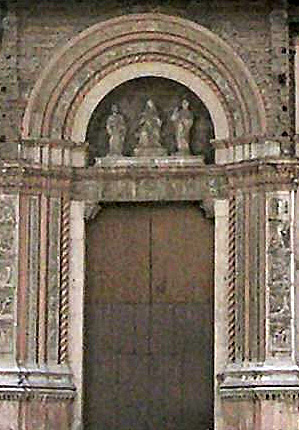
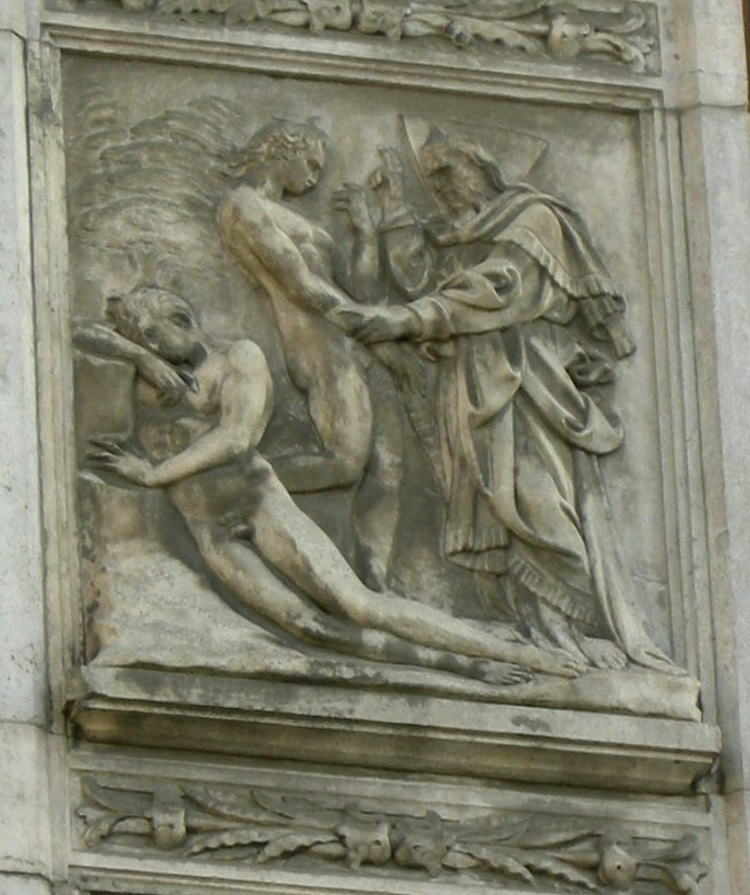
In 1425, Jacopo della Quercia embarked on another monumental undertaking: the design of the round-arched Porta Magna, the main portal of the San Petronio Basilica in Bologna. To obtain the necessary stone for this project, he traveled to Verona, Venice, and Milan. This commission would engage him for the greater part of the last thirteen years of his life and is widely considered his masterwork. Each side of the grand door is flanked by colonettes adorned with spirally wound decorations, followed by nine busts of prophets, and finally, five scenes from the Old Testament carved in a somewhat lower relief. Notably, in the Creation of Adam, della Quercia employed an arrangement similar to that seen in the Fonte Gaia in Siena, but in reverse order. The profound influence of these reliefs is evident in the work of Michelangelo, who visited Bologna in 1494 and later acknowledged that his famous Genesis frescoes on the Sistine Chapel ceiling were based on della Quercia's designs. Above the door, the architrave features five reliefs depicting scenes from the New Testament. The lunette above the arch contains three free-standing statues: the Virgin and Child, Saint Petronius (holding a model of Bologna), and Saint Ambrose. The statue of Saint Ambrose was carved by Domenico Aimo in 1510; originally, this third statue was intended to represent the papal legate, Cardinal Alemmano, but this plan was abandoned after the cardinal's eviction from Bologna. For this extensive project, della Quercia heavily relied on the skilled artists of his Bolognese workshop, including Cino di Bartolo.
2.6. Later Commissions and Unfinished Projects
In his final years, della Quercia became increasingly active, often working on multiple projects simultaneously. While still engaged with the Porta Magna, he was commissioned in 1434 by the Sienese authorities to design the Loggia di San Paolo, situated near the Piazza del Campo. However, he was unable to complete this commission before his death, having only finished the capitals and six niches. In 1435, he received several honors from the Sienese, including being knighted and appointed to the important position of Operaio (master builder or foreman) of the Siena Cathedral. During his last years, he was also involved in the decoration of the Chapel of Saint Sebastian (which was destroyed in 1645) for Cardinal Casini in the Siena Cathedral. However, most of these works, including a significant high relief depicting Cardinal Antonio Casini presented to the Virgin by St. Anthony of Egypt, were primarily executed by his Siena workshop. This relief is currently on display in the Hall of Statues within the Cathedral Museum.
3. Personal Life and Controversies
Jacopo della Quercia's personal life was not without its challenges, including a notable legal scandal that temporarily interrupted his career.
3.1. Legal Troubles and Scandals
In 1413, Jacopo della Quercia and his assistant, Giovanni da Imola, faced serious accusations, including theft, as well as rape and sodomy involving a woman named Clara Sembrini. Following these accusations, della Quercia fled to Siena, where he began working on the Fonte Gaia. His assistant, Giovanni da Imola, was incarcerated for three years as a result of the charges. Jacopo della Quercia was only able to return to Lucca in March 1416, having secured a letter of safe conduct, allowing him to resume his artistic endeavors.
4. Death and Burial
Jacopo della Quercia died in Siena on October 20, 1438. His burial place is in the Sant'Agostino church in Siena.
5. Legacy and Assessment
Jacopo della Quercia's contributions to Italian art were profound, positioning him as a crucial figure in the transition from the Gothic to the Renaissance. His work not only earned him high esteem from his contemporaries but also left an indelible mark on subsequent generations of artists, most notably Michelangelo.
5.1. Influence on Later Artists
Della Quercia's artistic impact on later Renaissance sculptors was significant. His unique blend of Gothic grace and classical monumentality provided a crucial bridge for artists seeking new forms of expression. Most notably, Michelangelo openly acknowledged the direct influence of della Quercia's biblical reliefs on the Porta Magna at San Petronio Basilica. Michelangelo's monumental Genesis frescoes on the Sistine Chapel ceiling were directly inspired by della Quercia's powerful and expressive compositions, particularly the Creation of Adam and Creation of Eve. Beyond Michelangelo, della Quercia's style influenced other prominent artists of the era, including Francesco di Giorgio Martini and Niccolo dell'Arca.
5.2. Critical Reception and Historical Significance
Jacopo della Quercia was highly esteemed by his contemporaries, including notable figures such as Lorenzo Ghiberti, Antonio Filarete, and Giovanni Santi. His importance was further solidified when Giorgio Vasari included a detailed biography of Jacopo della Quercia in his seminal work, Lives of the Most Excellent Painters, Sculptors, and Architects, published in the 16th century. This inclusion cemented his place within the pantheon of great Italian artists. Overall, della Quercia is recognized for his innovative contributions to sculpture, particularly his ability to infuse traditional Gothic forms with a new sense of classical grandeur and naturalism, making him a crucial transitional figure who paved the way for the High Renaissance. His work reflects a period of evolving aesthetic values and societal aspirations, marking a significant step in the development of Italian Renaissance art.
6. List of Major Works
- Madonna on top of the Piccolomini altar in the Siena Cathedral (1397-1400)
- Equestrian wooden statue for the funeral of Azzo Ubaldini (c. 1400)
- Knight of San Cassiano (Il Cavaliere di San Cassiano) (c. 1400) - Wood, 73 in (185 cm) high, Church of San Cassiano, San Cassiano di Controne
- Man of Sorrows (Altar of the Sacrament) and relief on the tomb of St. Aniello in Lucca Cathedral (early career)
- Virgin and Child (Silvestri Madonna) (1403) - Marble, 83 in (210 cm) high, Ferrara Cathedral
- St. Maurelius (c. 1403) - Ferrara Cathedral
- The tomb of Ilaria del Carretto (c. 1406) - Lucca Cathedral
- Fonte Gaia (1408-1419) - Siena
- Virtue (1409-1419) - Marble, 53 in (135 cm) high, Palazzo Pubblico, Siena
- Hope (1409-1419) - Marble, Palazzo Pubblico, Siena
- Acca Laurentia (1414-1419) - Marble, 64 in (162 cm) high, Palazzo Pubblico, Siena
- Rhea Sylvia (1414-1419) - Marble, 63 in (160 cm) high, Palazzo Pubblico, Siena
- Trenta family altar polyptych (1422) - Basilica di San Frediano, Lucca
- Annunciation, Virgin, and Gabriel (1421) - Polychromed wood statues, Collegiata in San Gimignano
- Porta Magna (1425) - San Petronio Basilica, Bologna
- Fountain, panels, and statuette of John the Baptist (1427) - Baptistery of Siena Cathedral
- Loggia di San Paolo (started 1434, unfinished) - Siena
- Decoration of the Chapel of Saint Sebastian for Cardinal Casini (final years, largely workshop) - Siena Cathedral